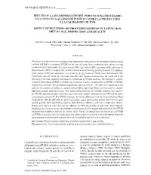Resultados: visualización detallada
Registro 1 de 1 para la búsqueda tipo de materia Poroto soya tratado, gallinas de postura, producción y calidad de huevos.
Efecto de la incorporación del poroto soya procesado a la dieta de gallinas de postura sobre la producción y la calidad del huevo
José Pokniak R.; Facultad de Ciencias Veterinarias y Pecuarias. Universidad de Chile.
Sergio Cornejo V.; Facultad de Ciencias Veterinarias y Pecuarias. Universidad de Chile.
Rodrigo Medel Q.; Facultad de Ciencias Veterinarias y Pecuarias. Universidad de Chile.
Katherine Tapia C.; Facultad de Ciencias Veterinarias y Pecuarias. Universidad de Chile.
Edith Contreras T.; Facultad de Ciencias Veterinarias y Pecuarias. Universidad de Chile.
2005
-
Datos de edición
Avances en Ciencias Veterinarias; Vol. 20, No. 1-2 (2005): Enero-Diciembre
Universidad de Chile - Tipo de Documento Libro
-
Materia
Poroto soya tratado, gallinas de postura, producción y calidad de huevos.
Treated soybean, laying hens, productive performance, eggs quality. -
Descripción
Se realizó un estudio durante 16 semanas con 216 gallinas blancas Leghorn - Lohman de 26 semanas de edad, para evaluar los efectos de la inclusión del poroto soya (POSO) procesado: tostado y extruido, a dietas de gallinas de postura sobre su respuesta productiva y la calidad de los huevos. Las aves se asignaron a tres tratamientos: control sin POSO en ...Se realizó un estudio durante 16 semanas con 216 gallinas blancas Leghorn - Lohman de 26 semanas de edad, para evaluar los efectos de la inclusión del poroto soya (POSO) procesado: tostado y extruido, a dietas de gallinas de postura sobre su respuesta productiva y la calidad de los huevos. Las aves se asignaron a tres tratamientos: control sin POSO en su dieta y los restantes (2 y 3) con 20% de POSO tostado o extruido. Las dietas fueron formuladas a mínimo costo con igual contenido de proteína y energía metabolizable.La información reunida señaló que el tratamiento POSO extruido fue superior (p s 0,05) a los otros tratamientos en consumo de alimento, porcentaje de postura, masa de huevos, conversión alimenticia (kg alimento/docena de huevos) y resistencia de la cáscara a la fractura; lo último sólo con el control. El tratamiento POSO tostado fue muy coincidente con el control en las diferentes variables evaluadas. Por su parte, el tratamiento control mostró mejor (p s 0,05) conversión (kg alimento/kg de huevo) y color de la yema que los otros tratamientos.Se concluye que el poroto soya tostado o extruido son recursos proteínicos alternativos a otras fuentes de proteína en la alimentación de gallinas de postura y su incorporación dependerá de su disponibilidad y precio al momento de la formulación de las dietas.The objective of this work was to produce local information with regard to the inclusion of full fat toasted soybean (FFTSB) or extruded (FFESB) in the diet of laying hens, evaluating their effects on: egg production (EP), feed intake (FI), body weight (BW), egg weight (EW), egg mass (EM), efficiency of feed utilization (EFU), mortality (M), and the externa/ and internal egg quality parameters. In addition, gross margin (GM) and aliment ...The objective of this work was to produce local information with regard to the inclusion of full fat toasted soybean (FFTSB) or extruded (FFESB) in the diet of laying hens, evaluating their effects on: egg production (EP), feed intake (FI), body weight (BW), egg weight (EW), egg mass (EM), efficiency of feed utilization (EFU), mortality (M), and the externa/ and internal egg quality parameters. In addition, gross margin (GM) and alimentary cost of the kg of egg produced (ACek) were determinated. The experiment was can - ied out for 16 weeks with 216 white Leghorn Lohman hens 26 weeks old at the beginning of the trial, randomly distributed in 3 treatments of 72 birds each one. The treatment 1, control, was fed a diet without FFTSB or FFESB; the treatments 2 and 3, included 20% of FFTSB or FFESB, respectively, all diets were formulated isoproteinic and isoenergetic. The data were subjected to the analysis of variance according to a model of fixed effects type 1 and Tukey test was used to compare differences among individual mean. The results pointed out that the FFESB treatment was superior for EP, EM and shell strengh to fracture, but on the other hand it obtained the less EFUs of the study, associated to a greater FI. The FFTSB treatment showed no differences with the Control Soybean Meal treatment for: BW, EP, EW, EM, FI, EFU (kg feed/doz. eggs), and cracked, broken and shell less eggs, specific gravity, shell deformation capacity, shell thickness, albumen: yolk ratio (weight and volume), Haugh units and yolk color, but was less efficient for EFU (kg foodlkg of eggs) than this treatment. Regarding the economic results, the FFESB treatment generated the biggest GM followed by the FFTSB treatment that in addition obtained the smallest ACke. Finally, the data pointed out that the use of FFESB or FFTSB in practical diets for laying hens may allow producers and feed milis to formulate diets with these alternative plant protein sources when their availability and prices be competitive.Facultad de Ciencias Veterinarias y Pecuarias
- Identificador 34761






